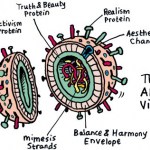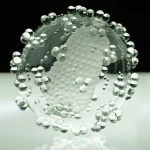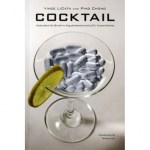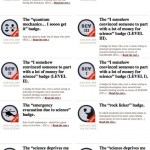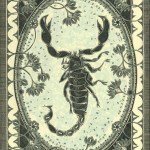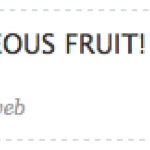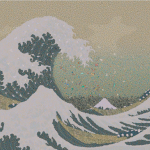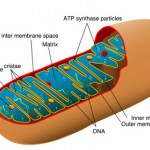The Art/Science (Non?)Divide Building
Science Scout Twitter Feed
Well, actually, mathematicians - but it would probably go like this:
CD Title: Inverse: (Special limited edition release) (2009)
Artist: VAMPIRE WEEKEND
Rating: 2.718 stars (out of 5)
- - -
The rating stands. (Spoiler alert: We rounded.) Actually, we took our cue here from Leonard Euler. Our rating is actually "e," as in the sound of the squeals that will inevitably emanate from the ladies of Cambridge after they all get a hold of Inverse come two months. Yes, M.I.T.'s finest are back with a shtick to shake up the innumerate masses for whom any further mention of…
Today, seedmagazine.com has a piece about Luke Jerram, the artist that I wrote about earlier (he of the incredible glass microbe structures). Anyway, I was asked to write something to go along with the piece, and have done so here.
It's funny, but I even felt a bit awkward writing this response (being asked to do a piece on Art and Science). I know I do this sort of thing in my lab, but having to comment intelligently about it feels weird to me.
Still, I do believe that precisely because "beauty is in the eye of the beholder," there's not one best way to talk science to the non-scientist…
Dear Luke,
I just saw a photo of your glass sculpture of HIV.
I can't stop looking at it. Knowing that millions of those guys are in me, and will be a part of me for the rest of my life. Your sculpture, even as a photo, has made HIV much more real for me than any photo or illustration I've ever seen. It's a very odd feeling seeing my enemy, and the eventual likely cause of my death, and finding it so beautiful.
Thankyou.
The above is letter inspired by some glass sculptures delicately created by Luke Jerram. They are spectacular, and I'm pretty sure you don't need to be a science junkie to…
A review of Cocktail: A Play about the Life and HIV Drug Development Work of Dr. Krisana Kraisintu by Vince LiCata and Ping Chong
Truth be told, I don't read plays very often, if at all. In fact, I'm ashamed to admit that I think the last one I read was back in high school long ago, and if I remember correctly had something to do with vampires - ironic in that vampires at the time were not so popular. But this play was about something I am interested in - medicine and social responsibility - and it was referred to by a friend, who also happened to be one of the authors.
Coincidentally,…
This is up (I'm sure) everywhere, but I can't resist also showing it off, especially since I've played around with the science song genre myself.
And you can buy the CD/DVD set for yourself (or your kids) at Amazon.
I had the chance to interview Rebecca Solnit for The Believer. It's on shelves now, in their September issue. They've also put the full text of it on-line at their website. (Here it is.)
To quote the interview's intro, Solnit is the author of twelve books. She is a journalist, essayist, environmentalist, historian, and art critic; she is a contributing editor to Harper's, a columnist for Orion, and a regular contributor to Tomdispatch.com and The Nation; she's also written for, among other publications, the L.A. Times, the San Francisco Chronicle, and the London Review of Books.
She talks…
I haven't been here much, but I did begin a new series over at McSweeney's called "Days at the Museum." It's a limited-run set of dispatches (summer-length, let's say) about research at the Smithsonian and related miscellany. Tuesday was the first one, called "Ronzoni All the Way Down."
This is the central image of the story, a fairly well-known portrait by the French Barbizon artist Jean-Francois Millet from 1857 called "The Gleaners":
And what is the story? I'll repost it in full below the fold. I'd bet it's fair to say it has the character of one of Lawrence Weschler's Convergences…
Alas, I have a book cover to share for Notes from the Ground! I'm pleased with it. I was even brought to use an exclamation point just there.
It happens, I know it, it happens, people judge these things by their covers. I don't say so to be cutesy or play the cliche. I'm just acknowledging it happens. I've done it. Not infrequently, in fact. The one for this book is a plate from the 1697 John Dryden translation of Virgil's The Georgics, one of his epics and the one that threads through the book underneath the cover. I'm excited to see it. Make posters, put it on your walls, behold,…
Among other things, John Stuart Mill wrote about deliberation in a democratic society. It's the philosophy that a strong democracy is one whose members are actively involved in the functioning of that government. This, as opposed to a passive, distanced, and unreflective citizenry. Engagement and participation into the activity of the society offer benefits in at least two directions: in one way, they make for a stronger democratic society as a whole by demanding connections between the everyday life of the citizens and the everyday operations of the government; this is an advantage that…
Just a quick heads up to let you know that the Science Scout website has been completely revamped. It's now capable of accepting comments (anecdotes) of why you feel particularly inclined to deserve certain badges.
As well, there are a few these new badges for you to peruse through:
And the start of an attempt to organize according to locale (separate Facebook group sites for individual cities - starting with Vancouver, New York, and London).
But here's the best bit of news...
We're working on real badges! That's right! Nerd Merit Badges are game on to see if they can make some for us.…
Science Scout Twitter feed
Crustaceans are a very large group of arthropods, comprising almost 52,000 described species, and are usually treated as a subphylum. They include various familiar animals, such as crabs, lobsters, crayfish, shrimp, krill and barnacles (from wiki).
- - -
This collage art by Mark Wagner is pretty wild. As well, there's a great interview you can read at The Morning News.
I was making a lot of collage and artists books using Camel Cigarette packages. To a large extent it was the familiarity of the pack for people that made the work effective. That led me to the…
Science Scout twitter feed
In botany, a pome (after the Latin name for fruit: pomum) is a type of fruit produced by flowering plants in the subfamily Maloideae of the family Rosaceae.(from wiki)
- - -
Today at the Science Creative Quarterly we have this great story written by Matt McKenna.
For those of you unfamiliar with the SCQ, it's sort of a science web publication whose most mentioned comparison is the McSweeney's website (not a bad thing to be compared to, and to be honest, I quite like the site having the label, "McSweeney's for Sciencegeeks.")
Anyway, the SCQ has actually been…
Science Scout twitter feed
Thanks so much for all the great feedback with the Mitochondria song, and as promised, I picked a request from the comments for my next attempt at song writing. Specifically, this one:
That's right - we're talking about the Buckminsterfullerene!
Here is the demo mp3 for your listening pleasure (might be best with headphones), and the lyrics reprinted for all to see below:
Buckminsterfullerene
it's the craziest thing you've ever seen
C60 in my dreams
It's a real life chemical celebrity scene
Good enough to catch a nobel prize
But more than that it's easy on…
Science Scout twitter feed
Recently, I heard of a new documentary called "Act of God" by Jennifer Baichwal, that involved looking at individuals struck by lightning.
I haven't had a chance to check out this new film, but it did remind me of a previous movie that she had done called "Manufactured Landscapes," which highlighted the remarkable photography of Edward Burtynsky.
And whilst thinking about this, I've stumbled across Edward's great website which has some of the most striking imagery I've seen in a long time (Click on the images to get to a larger version and title on Edward's…
I'll be headed to D.C. next week to start a research Fellowship at the Smithsonian's National Museum of American History (above). This is a signal of transitions in several senses. Not only has the semester ended here (with graduation this Sunday and so far only two students protesting their grades), but I am officially finished with the major research project of the last many years and into the next major one. This last project culminates in my book, Notes from the Ground: Science, Soil, and Society in the American Countryside, on shelves this September. The new project, "The Moral…
Science Scout twitter feed
Tonight, I'll be heading out to the Vancouver Cafe Scientifique, where noted bee biologist, Dr. Mark Winston, will be giving a talk about science and dance (May 12th, 7:30pm at the Railway Club).
Now, although the linkage between dancing, science, and bees would be normally fairly straight forward, I've been told that tonight's presentation would be more an exploration about dancing as an art form and as a way of creatively expressing science.
I'm pretty keen to check it out myself since my own lab does a fair bit of art + science endeavours (although…
I guest authored a post for the ineluctable The Education of Oronte Churm, over at Inside Higher Ed. The good Mr. Churm (John Griswold) has guest written for us as well, as with this John and Paul Project post from last year and this one, from two years past, on Hot Funky Love.
But please, by all means, go read the new post at his blog in full. It's theme? Creativity, imagination, grammar. It's purpose? To ponder the identity of the artist, the engineer, the department of vehicles.
And this one license plate I saw that really confused me: "ICR8 ART."
An excerpt below.
One would first…
Science Scout twitter feed
Chris Jordan has done it again. And if you're not sure who this fellow is, then let me be the first to introduce you to this digital artist extraordinaire, who creates these magnificent images of consumption in our world.
The latest is a little mindboggling to say the least. Called "Gyre," this image:
Depicts 2.4 million pieces of plastic, equal to the estimated number of pounds of plastic pollution that enter the world's oceans every hour. All of the plastic in this image was collected from the Pacific Ocean.
Now these images are huge - this one being 8 by…
Science Scout twitter feed
Continuing on with my promise to play around with this science songwriting thing (1, 2), here is the third song in my World's Fair repertoire. This one on the awesome mitochondrion!
Here is the demo mp3 for your listening pleasure (might be best with headphones), and the lyrics reprinted for all to see below:
MITOCHONDRIA!
(verses)
Floating round in a cell,
making A T P
In your own kind of hell
in the cytoplasmic sea
You got own DNA
Came maternally
Never sure how you stayed
Endosymbiotically
(Chorus)
Mitochondria, Mitochondria, Mitochondria, Mitochondria…
Science Scout twitter feed
The other day I was looking for an interesting periodic table graphic for the background image of the science scout twitter account, and whilst doing so I came across many many different versions of the famous layout. However, I also noticed that a lot of them didn't have anything to do with elements at all, and so thought it might be interesting to collect a bunch of them for folks to check out here.
We'll start with my favourite (and one that has been previously showcased here at the World's Fair): the lego periodic table of elements.
When shown previously…

